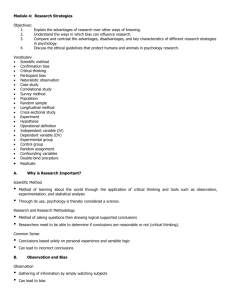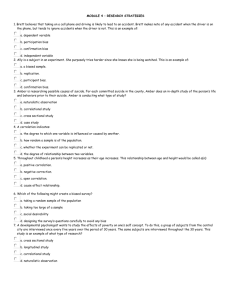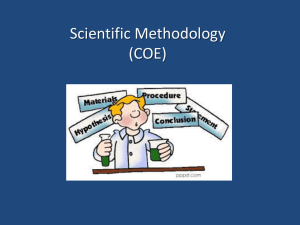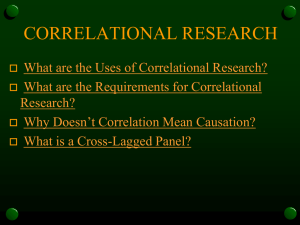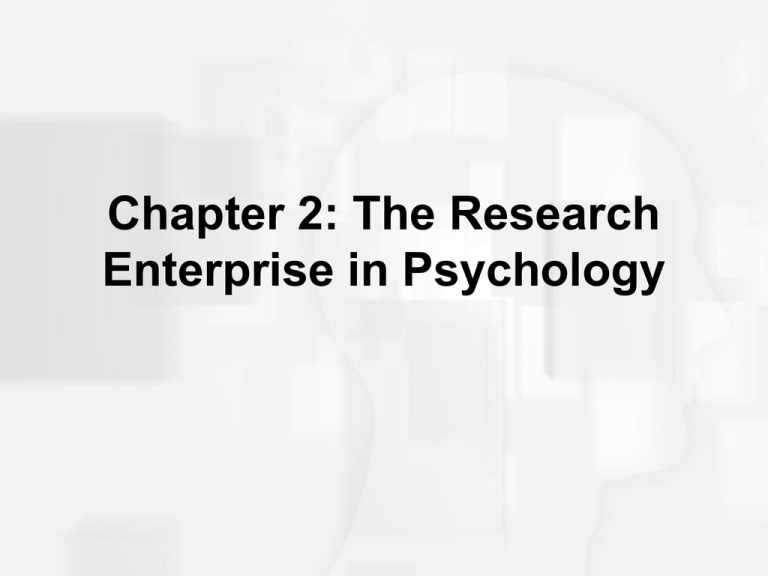
Chapter 2: The Research
Enterprise in Psychology
The Scientific Approach to Behavior
• Basic assumption:
– events are governed by some lawful order
– Deterministic Viewpoint
– Free Will cannot be studied scientifically
The Scientific Approach to Behavior
• Goals:
– Measurement and Description
• Qualitative and Quantitative
– Understanding and Prediction
• Theory
• Hypothesis
– Application and Control
• Help improve people’s lives
Steps in a Scientific Investigation
1. Formulate a testable hypothesis
– Operational Definition
• “Studying in a brightly colored room improves
learning.”
– Brightly Colored Room
– Learning
• “People with a high self-esteem are more
successful.”
– High Self Esteem
– Successful
Steps in a Scientific Investigation
2. Select the research method and design the
study
• “Males are more aggressive than females.”
• Methods
– Laboratory
– Observations
– Questionnaire
– Evaluation of other data (courts, police
records)
Steps in a Scientific Investigation
3. Collect the data
–
–
–
Recruit Sample
Conduct Study
Collect data
Steps in a Scientific Investigation
4. Analyze the data and draw conclusions
–
–
Use statistics
Was the hypothesis supported by the data?
Steps in a Scientific Investigation
5. Report the findings
–
–
–
–
Ensures accurate data
Check each other
Furthers research
Helps the profession
Types of Research
• Experimental
• Correlational
• Descriptive
Experimental Research
• Experiment =
– Type of research where the researcher
manipulates of one variable under
controlled conditions and observes
changes in a second variable
– Detection of cause-and-effect relationships
Experimental Research
• Independent variable (IV) =
– The variable that is manipulated
– The possible “cause”
• Dependent variable (DV) =
– The variable that is measured
– The “outcome or effect”
• Extraneous and confounding variables=
– Any other variable affecting the outcome
Experimental and Control Groups
• Experimental group
– Receives the special condition (the IV)
• Control group
– Does not receive special condition
• Important
– Random assignment
– Manipulate IV for group only
– Differences in the two groups must be due
to the independent variable
Strengths and Weaknesses
of Experimental Research
• Strengths:
– conclusions about cause-and-effect can be
drawn
• Weaknesses:
– artificial nature of experiments
– ethical and practical issues
Correlational Research
• Assesses the relationship between two
variables.
• Cannot establish Cause and Effect
Correlation
• Correlation coefficient
– +1.00 to -1.00
– Direction of relationship (+/-)
– Strength of relationship (#)
• Correlation and prediction
Figure 2.6 Positive and negative correlation
Descriptive Methods
• Methods used when a researcher cannot
manipulate the variables under study
– Naturalistic observation
– Case studies
– Surveys
• Allow researchers to describe patterns of
behavior and discover links or associations
between variables but cannot imply causation
Figure 2.10 Comparison of major research methods
Evaluating Research:
Methodological Pitfalls
• Sampling Bias
• Placebo Effects
• Distortions in Self-Report Data:
– Social desirability bias
– Response set
– Memory
• Experimenter Bias
– the Double-Blind Solution
• Demand Characteristics
What’s Wrong
• A psychologist is conducting an experiment to
determine whether exposure to pornography causes
men to commit more sexual crimes. She randomly
assigns 20 men to the experimental group, who
watch a pornographic film, and 20 men to the control
group, who watch an exciting, but not pornographic
film, of the same length.
• After the film, she interviews the men and asks them
whether they fell that they would be likely to commit a
sex crime. The results show the more of the men
who say the pornographic film say they would be
likely to commit a sex crim.
Ethics in Psychological Research:
Do the Ends Justify the Means?
• The question of deception
• The question of animal research
– Controversy among psychologists and the
public
• Ethical standards for research: the American
Psychological Association
– Ensures both human and animal subjects
are treated with dignity
Figure 2.12 Ethics in research




